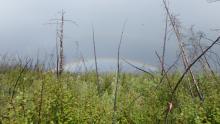Update
Now Archived! PolarConnect event with Stan Skotnicki and Mike Loranty from the Northeast Scientific Station in Russia on Tuesday, 12 July 2016. You can access this and other events by visiting the PolarConnect Archives. https://www.polartrec.com/polar-connect/archive
What Are They Doing?
 Peter Ganzlin and Bradi Jo Petronio at one of their moss plots. Photo by Mark Paricio.
Peter Ganzlin and Bradi Jo Petronio at one of their moss plots. Photo by Mark Paricio.
The goal of our project is to understand how terrestrial ecosystems influence permafrost temperatures. There are places in the Arctic where climate is warming but permafrost temperatures are stable, while at other places permafrost temperatures are rising rapidly with climate. Soil and vegetation that sit on top of permafrost can either promote heat transfer or act as insulators. Our project will use field measurements at research sites throughout Alaska and Siberia to identify broad trends in relationships between ecosystems and permafrost temperature dynamics. At research sites in Siberia we will make detailed measurements to identify the processes responsible for these trends. This work will help to understand the effects of Arctic vegetation change on permafrost temperatures.
Where Are They?
 A tugboat pushes the barge past the old river port of Cherskiy, Russia. Photo by Mark Paricio.
A tugboat pushes the barge past the old river port of Cherskiy, Russia. Photo by Mark Paricio.
We will be working from the Northeast Scientific Station near the town of Cherskiy in the Siberian Arctic. The station is located on the Kolyma River, only 60 miles from the Arctic Ocean by boat. We often work long hours because the sun doesn’t go down, but we are well fed on a steady diet of moose. At places where the river bank is eroding and thawing the permafrost we sometimes find mammoth bones!
Latest Journals

Mike Loranty is an Assistant Professor of Geography at Colgate University who studies how carbon, water, and energy are exchanged between terrestrial ecosystems and the atmosphere. Dr. Loranty’s current research projects are focused on understanding how boreal forest and arctic tundra ecosystems respond and feed back to climate warming. His work utilizes field observations, models, and satellite remote sensing. Much of his work is focused on the Siberian arctic, and this summer will be his sixth field season there.





